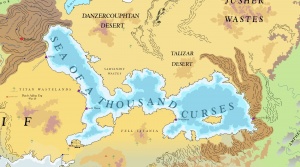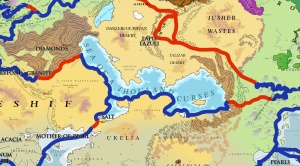Difference between revisions of "Sea of a Thousand Curses"
Trismegistus (talk | contribs) m (→Commercial) |
Trismegistus (talk | contribs) m (→Sea Also) |
||
| Line 27: | Line 27: | ||
[[Category:Asdauria]] | [[Category:Asdauria]] | ||
[[Category:Inland Seas]] | [[Category:Inland Seas]] | ||
| + | [[Category:Inland Bodies of Water]] | ||
{{stub}} | {{stub}} | ||
Revision as of 19:48, 11 January 2015

The Sea of a Thousand Curses is the largest inland body of water in the great continent of Asdauria. The sea of a Thousand Curses is very irregular in shape, but reaches more or less from east to west and separates the regions of Weshif and Ukelia from the High Deserts of central Asdauria to the north. It is bounded by severe deserts and barren mountains on all sides. The waters are more saline than the ocean, so any merchants who voyage upon it must bring their own water. The highest mountains along its coast are the Adamantine Mountains which line its northwestern tongue.
In ancient times, the sea was the habitation of the Salt Dragon now thought to be extinct or nearly so. Its waters are often traversed by merchants as part of the commercial exchange between east and west, particularly between Sungo and Opaz and the nations of the greater Pallathantic Region.
Magdeology
Scholars believe the sea is slowly shrinking due to the ongoing effects of desertification that have been in effect for millennia since the Age of Ice and Fire. The greatest depth of the sea is unknown, but may be very deep and thus the sea may abound in water, resisting the effects of desertification. The waters of the sea are very saline and only life which is especially suited to this environment can dwell in it.
Origin of Name
Since ancient times, the sea has been associated with the legendary destruction thought to have visited the antediluvian civilization of the titans. For this reason, it is called the Sea of a Thousand Curses, the curses being the devastation which befell the titans. The oldest Hœrnectian legends report that the fantastic cities of the titans lined it shores and now rest underneath the depths of endless desert sands. This reputation has drawn countless adventurers and treasure hunters without any lasting influence on modern scholarship or their fortunes.
Commercial
The sea is an important route of merchant caravans from the far east. The lack of organized government along its coast requires such caravans to provide their own protection from bandits and pirates. The greatest merchant families and corpora mercia who regularly use the sea for transportation maintain small fleets for this purpose in special port cities along at its eastern and western ends. Most vessels skirt the southern coast of the sea. The greatest ports are Gwam-Pho-Thar on the far eastern end, Ulkhazharza, Faadh Ehrun, Esgush, and Adhiruz in the northwest branch, south of the Adamantine Mountains.
As the sea does not have cyclonic storm systems like the open ocean, the merchant vessels that ply its waters are large caravel ships. In the past sixty years, titancraft ships have voyaged the sea, carrying tonnages of merchandise east and west. However, water spouts are not unheard of.
The city of Dhaalizoond rests on the shore of the southernmost point of the sea. It is an major port for merchants traversing the sea and is also an important site for the industrial production of salt. As Dhaalizoond is located in the southwestern branch of the sea, it is often passed by merchants en route between Gwam-Pho-Thar and Adhiruz to cut down on time.
Sea Also
| This article is a stub. It requires further development by the creator. |
